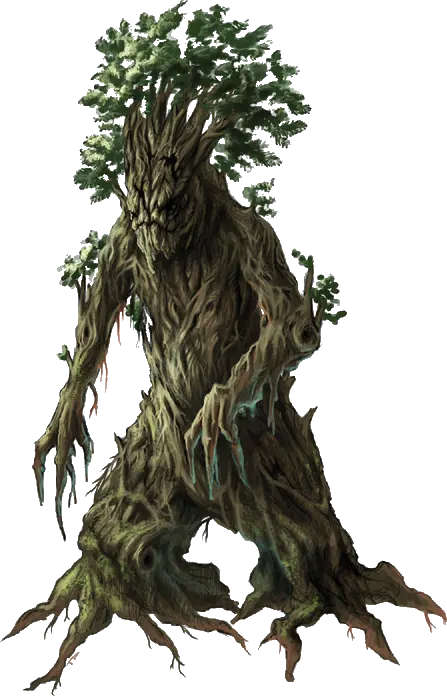“Today, little Alrik, I want to tell you something about treants. They are living trees with souls, just like us. Like people, some of them are good and some are evil. The good ones can help you if you get lost in the woods, as they lead you back out again. If they like you, they may even give you nuts and fruit. No, not from their own branches, little Alrik. They are beings that are much older than us and they are very proud. You should never laugh at them, as they do not like that. And stay away from the bad ones. They kill people, whom they consider intruders. Well, they might be right about that one. You should especially keep away from rowan treants, they are not to be trusted.”
— Grandpa Elwain to his grandson Alrik, Winhall, 1037 FB
Little is known about the origin of these tree-tall beings. When standing still, they are difficult to discern from the surrounding trees. These 10— to 13-foot tall beings are called treants for a reason. They look like gigantic mixtures of man and tree. Although most of them have arms and legs, they grow branches and twigs from their bark-covered bodies (which are not made of flesh and bone but rather wood and resin). Treants have never been known to use tools and clothing, but they possess excellent minds and speak a creaking language. Depending on species, treants can live as long as 1,000 years.
Distribution
Treants can be found in forests and groves all over the continent, but they are encountered most often in the vast forests of the north. Notably, treants are differentiated by the species of tree to which they belong. Fir, spruce, and pine treants live in the dense, coniferous forests of the north and claim entire forests for themselves. Fir treants, it is said, are wise and noble, while spruce treants are regarded as rather war-like. Unlike them, pine treants seem to be rather quiet fellows. The less durable birch and aspen treants usually make their homes in smaller groves and woods. Birch treants are the most curious and can be fairly intrusive, while aspen treants are said to be very sociable. Larch treants, which are mostly female, are considered very just and are a rare sight, indeed.
In the lowlands of the north and the deciduous forests of the Middenlands, one is more likely to encounter beech and oak treants, and, rarely, elm treants. While beech treants are deemed strong and stable, it is said oak treants are just but quarrelsome. It is said elm treants possess amazing magical abilities. Gloomy and unforgiving ash treants are regarded with suspicion, even among other treants. It is said that yew treants take century-long journeys through Aventuria.
In the Deep South, one finds mohagoni and coral tree treants, but they are known only to the tribes of the Rain Mountains. Lone irontree treants are said to wander the jungle on Maraskan. They deemed to be prideful and resilient.
Way of Life
Treants usually live on their own or in small families. They all have a love for the forest and nature in common. They defend their forest fiercely against any troublemaker who dares to strike even one of their trees with an axe. They will remain motionless and watch wanderers, trying to be mistaken for trees. This way they let loggers and charcoal burners come close so they can strike them all of a sudden.
Some treants understand human languages, especially birch and aspen treants, who sometimes stay close to resting places or human dwellings to watch the, in their eyes, always industrious fleshlings. Treants find it very difficult, however, to tell humans apart from orcs or goblins, or even to recognize individual humans if they should meet them again. Therefore, they often make one person responsible for the acts of another. Some treants seem to stay in close contact with fairies, kobolds, or unicorns, or are friendly with trolls or druids.
At irregular intervals, treants meet for the Ratbazamithing (treant for: mighty, all serving thing/discussion/council), a large meeting where treants discuss important issues. Apparently, treants have a method for communicating over wide distances, but to date no scholar knows if they communicate by magic, the rustling of leaves, or the flight of pollen.


